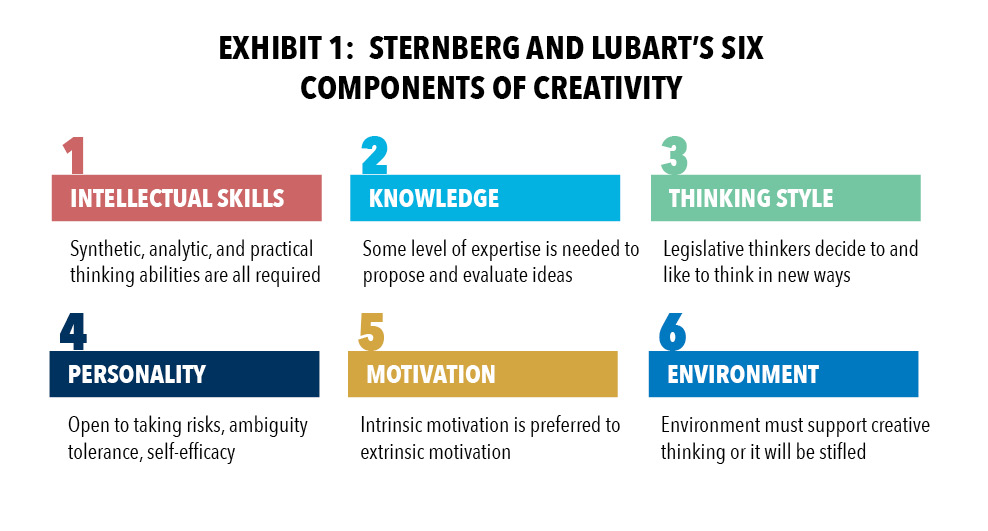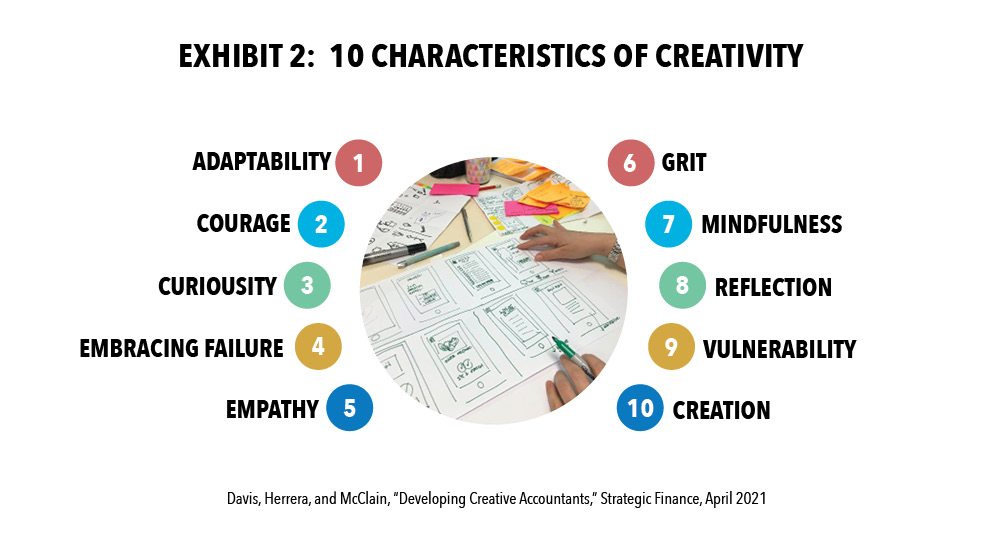Today’s students are increasingly seeking career paths that embrace innovative thinking and ideas. Yet historically, creativity has been deemed antithetical to the work of accounting and finance professionals. People aren’t looking for a creative accountant. In fact, the words “creative” and “accountant” can evoke all sorts of red flags when used together.
But in a business environment driven by constant change, maybe it’s time to reconsider how relevant creativity can be to our profession. Today, solutions must be identified quickly—and in a way that minimizes risk. And that makes management accountants who can think outside the box a strategic asset to employers.
Consider a recent article on PwC’s strategy+business site, which explores how creative people are willing to take social risks. By speaking up without permission, these people inject a creative spark for problem-solving and decision-making. Accounting and finance professionals often deal with risk, so developing creativity seems imperative.
Accounting educators who begin to foster and develop students’ use of creativity alongside their accounting technical knowledge can change students’ perceptions about the field. By empowering students to embrace creativity at the outset of their professional journey, educators can help infuse the accounting profession with more well-rounded talent.
Redefining Creativity
While many people equate creativity to artistic ability, that doesn’t come close to describing its power in the business world. Of the many experts who’ve tried to define it—from writers to scientists—they all agree that creativity boils down to innovative problem-solving.
Being creative is a choice. As Robert J. Sternberg and Todd Lubart’s investment theory of creativity proposes, creativity is not an innate trait. Rather, it’s a conscious choice of activities and attitudes that are grouped into the six components that relate to different traits shown in Exhibit 1. Components 1, 2, and 3 are cognitive traits, components 4 and 5 are affective traits, and component 6 is a cultural trait.
Creative thinkers rely on a combination of intellectual skills when solving problems. First, generating ideas requires an understanding of the big picture and synthesizing knowledge in new ways. Then they can evaluate and interpret these new ideas based on data from past experiences. It’s this combination that fuels creative thinking—implementing novel solutions with practical thinking to bring ideas to reality.
But having these intellectual skills isn’t enough. They also need functional and contextual knowledge to propose and evaluate ideas. Thinking styles also influence creativity, and those problem-solvers who prefer creating, planning, imagining, and formulating often exhibit higher levels of creativity.
Having a venturesome personality—one that’s open to risk-taking and tolerant of ambiguity— fosters creativity, since creative work is often about solving ill-defined problems where the first (or second or third) solution is unsuccessful. For creative thinkers, motivation is primarily intrinsic. They’re motivated not by external incentives, but by the challenge and satisfaction they find in the creative process.
Finally, creative thinkers need a supportive environment or their work will stagnate. Companies like 3M and Google have famously fostered such environments by encouraging their employees to set aside part of their work time to pursue creative and innovative ideas that excite them—with the knowledge that offering this dedicated innovation time can also be a boon to the companies. And indeed it has been; both Post-it® Notes and Gmail were born out of these initiatives.
Why Bring Creativity into the Accounting Classroom?
Of course, creativity isn’t a single trait—it’s a medley of personal characteristics that interact to influence and inspire behavior. A previous Strategic Finance article summarized 10 characteristics of creativity (see Exhibit 2). Developing these individual characteristics also improves creative thinking. Indeed, creativity can be developed and improved, which means that, as educators, we can help our students develop their ability to think differently.
A central and shared challenge for educators is helping students develop the foundational knowledge and skills to succeed in the workplace. In developing curriculum and assignments, we often turn to employers to help identify desirable skills. That’s why accounting programs began emphasizing oral and written communication skills several years ago, and why today data analytics and AI are being woven into curriculums.
Now it’s time to add creativity. While a 2019 LinkedIn report said creativity was the most needed soft skill in the workforce, a 2021 Wiley Education Services survey found that creativity is the third-hardest skill for employers to fill. But educators must take steps to ensure they don’t stifle creativity in accounting classrooms. For example, a typical test includes multiple-choice questions that require little to no creativity to select the correct answer. Clearly, the knowledge and accuracy measured by these types of questions are important in accounting education. But if that’s the only way we’re assessing knowledge, then we’re likely contributing to our students’ lack of creative thinking.
How Can We Bring Creativity into the Accounting Classroom?
Creativity in the classroom goes well beyond developing new ways to present material and engage students. Instructors also must help students develop their personal creativity. Instructors can design classroom practices, techniques, assignments, and activities that develop topical knowledge while simultaneously encouraging students to develop one or more of the 10 characteristics of creativity.
This doesn’t mean deleting technical accounting content. Rather, the integration of creativity should be similar to how instructors incorporate the development of communication and data analysis skills. Ready to start thinking about how to develop your students’ creativity? Try these techniques that can be applied in the accounting classroom.
General Creativity Development Techniques
- Wheel of misfortune. Just before they make a presentation, have students spin the wheel of misfortune (or draw a slip of paper out of a hat) to introduce an unexpected situation, like:
- a presentation technical glitch (such as the PowerPoint crashing or projector bulb burning out partway through), making their slides unusable
- a group member falling ill and missing the presentation
- cutting short the time allowed for the presentation
- Question journal. Ask students to record questions and confusion they have throughout the semester in a journal. This is a way for students to foster curiosity and grit, and to develop vulnerability by admitting when they don’t understand a topic.
- Assessment review. After receiving feedback on an assignment or an exam, have students reflect on their performance. Ask them to rework the assignment, correct their errors, and explain those mistakes and how they plan to fix them. Then students can embrace failure and develop a strategy to learn from their mistakes.
- Challenge negative thinking. Students often provide reasons why something can’t be done or can’t be correct. As you lead discussions with students, encourage positive thinking instead by asking “How can we . . .?” or “How could this be correct?” Consider presenting a scenario that asks how a tricky task could be accomplished to develop their curiosity and adaptability.
- Write a case. Have students write an instructional case or teaching guide about a course topic. This will encourage them to formulate questions and empathy as they place themselves in the protagonist’s shoes to understand issues and arrive at workable solutions.
- Community consulting. Have students apply what they’re learning in the classroom by providing consultative services to a community partner or local business. Helping a company solve an issue helps students develop empathy by seeking to understand said issue from the company’s perspective. Students will learn to ask better questions and, in turn, find better solutions. As a final step, have students present the final consulting report to company management, as it helps develop courage—especially if the report covers difficult issues.
- Student teaching. Assign students a topic to teach the class and have them create a lesson plan that addresses a specific creativity characteristic. Teaching to their peers will help students develop courage and comfort with vulnerability.
Class-Specific Creativity Development Assignments
- Financial accounting. Ask students to develop and apply a new Generally Accepted Accounting Principles standard. The standard could be for a current issue, such as cryptocurrency, or a revision of an existing standard. Researching current financial reporting topics could inspire students to propose new ideas. Ask practitioners, perhaps from the department’s advisory board, to apply the developed standard and discuss the results with the class. Then have the students reflect on whether the proposed standard was applied as they expected and whether changes should be made to provide sufficient implementation guidance. Creativity characteristics developed in this assignment include curiosity, empathy, and creation.
In addition, students can read a current Financial Accounting Standards Board (FASB) exposure draft and write a comment letter, or review comment letters on the FASB website and prepare a mock board response. This will help them understand the issues around the exposure draft, leaning into skills like curiosity and empathy.
- Taxation. Ask students to rewrite a section of the tax code in terms that their grandparents could understand. Alternatively, have them create or revise a code section to address a current tax issue in the news. This assignment develops the creativity characteristics of empathy, curiosity, and reflection.
- Auditing. Assign students to teams and conduct a brainstorming session to assess internal controls and identify the potential for fraud. To add additional professional relevance, bring in an auditing professional to help lead and debrief the brainstorming sessions. Students will develop reflection, empathy, and curiosity as they brainstorm.
- Cost and managerial. Ask students to build a balanced scorecard and/or a dashboard for management to monitor strategy achievement. Students will develop empathy and curiosity as they work to understand what information the dashboard or scorecard needs and how to best present it.
- Accounting information systems. Have students design and/or build a system to collect and report data about a particular transaction or transaction cycle. Students will develop grit, practice reflection, and embrace failure as they learn the software and build the system.
AI and Creativity Development Assignments
AI’s impact on the accounting classroom and profession can’t be ignored. Employers expect new accountants to understand how to partner with AI tools to enhance performance and improve task efficiency. Initially, one might think AI will inhibit accountants’ creativity by “doing the work.” However, AI might actually increase the need for accountants to think creatively since its results are only as good as the prompts feeding the tool.
Accounting instructors can address creativity while using AI with assignments that focus on prompt engineering. Many of the assignments discussed above can be adapted for use with AI to provide students with opportunities to enhance their adaptability, curiosity, and creativity.
The following examples incorporate AI into the creativity assignments suggested above. Notice that these assignments first require students to think creatively before using any AI tools. This shows students how AI can enhance their tasks—not just complete them.
- Question journal. Have students develop a prompt (or a series of successive refining prompts) for using AI tools to generate answers to their unresolved questions. Students can evaluate the responses and provide a summary as to how the class discussion could have been altered to answer their questions.
- Write a case. After submitting their case, have students use an AI tool to edit it. After students prepare a solution, have them compare their solution to one they generate with AI. These solutions can be shared with the original authors of the case to assess AI’s relevance and their original thoughts as to case solutions.
- Cost and managerial. Have students use AI to develop a balanced scorecard. They can compare their organically created scorecard to the AI-generated one and evaluate which is most appropriate. Students can also use AI tools to identify specific KPIs or metrics to include in their scorecards.
Developing creativity might be a new skill for students, so instructors should provide adequate support for assignments to guide students' work. Having intentional discussions about creativity will illustrate its importance before it is incorporated into specific accounting assignments.
Consider reviewing the 10 characteristics (Exhibit 2) early in the semester and talking about how these traits are critical for students’ future professional success. When you introduce an assignment or activity to build creativity, refer to those characteristics and remind students why they need to focus on more than just the assignment’s accounting content.
As you begin implementing new creativity exercises into your courses, remember that you will need to:
- Be courageous. It will be risky, scary, and uncomfortable. But the more you do it, the easier it will become.
- Embrace failure. New activities don’t always (if ever) work the way we plan. When a new exercise flops, embrace the failure, reflect on it, and make adjustments for the future.
- Be vulnerable. When a new assignment fails, admit that to the students and discuss what components didn’t work as planned.
- Reflect. Think about what went well and what didn’t. Determine how you’ll adapt the assignment for next time. And don’t forget to ask the students to reflect with you.
As Albert Einstein reportedly said, “Creativity is intelligence having fun.” So go have some fun—and bring creativity into your classroom.





